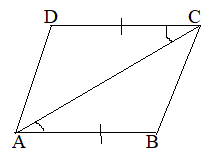Quadrilateral as the name itself says that it is a polygon with four sides. On the other hand, a parallelogram is a type of quadrilateral with both opposite sides are parallel and equal. In these previous articles, we have discussed all the properties of a parallelogram with theorems and examples. Now in this article, we will discuss the conditions for classification of quadrilaterals and parallelograms.
Related Articles:
- Diagonals of a Parallelogram are Equal & Intersect at Right Angles
- A Quadrilateral is a Parallelogram if its Diagonals Bisect Each Other
What is Quadrilateral?
In geometry, a quadrilateral is a polygon with four edges, four angles, and four vertices. It has four vertices namely A, B, C, D. The quadrilaterals are either self-intersecting or non-self-intersecting. Types of quadrilaterals are irregular quadrilateral, trapezium, parallelogram, kite, rhombus, rectangle, and square. We can measure the quadrilateral in terms of area and perimeter.
What is Parallelogram?
In maths, a parallelogram is a type of quadrilateral with opposite sides being parallel and opposite angles being equal. It has four edges, four vertices, and also four angles. The sum of angles of the parallelogram is 360 degrees. The parallelogram can be measured in terms of area and perimeter. Examples of parallelograms are rectangles, squares, and rhombus.
Conditions that Make a Quadrilateral a Parallelogram
A quadrilateral is a parallelogram if any one of the following is true
- Each pair of opposite sides are parallel.
- Each pair of opposite sides are equal.
- Each pair of opposite angles are equal.
- Diagonals bisect each other.
- One pair of opposite sides are parallel and equal
Let us discuss the condition for a quadrilateral to be a parallelogram with a theorem.
Theorem:
A quadrilateral is a parallelogram if a pair of opposite sides are equal and parallel.
Prove:
In a quadrilateral ABCD, the side AB is equal to the side DC.

Therefore AB = CD
Also, the side AB is parallel to the DC.
That is AB || CD.
Now, draw the diagonal AC.
We know that a diagonal of a parallelogram divides the parallelogram into two congruent triangles.
By using the Side-Angle-Side (SAS rule), we can prove that
∆ ABC ≅ ∆ CDA.
Hence, the side BC is parallel to AD.
Therefore BC || AD
Therefore, ABCD is a parallelogram.
Hence proved.
Parallelogram Vs. Quadrilateral
1. A quadrilateral is a 2D figure that has four sides and four angles.
2. In a parallelogram opposite sides are equal and parallel.
3. All the parallelogram are quadrilaterals but all the quadrilaterals are not parallelograms.
FAQs on What are the Conditions for a Quadrilateral to be a Parallelogram?
1. What are the classification of the quadrilateral?
The classification of quadrilaterals is quadrilaterals, rectangle, rhombus, parallelogram, square.
2. What quadrilaterals can be classified as parallelograms?
A parallelogram has opposite sides parallel and equal in length. Squares, Rectangle, Rhombus are all parallelograms.
3. When can a quadrilateral be called a parallelogram?
A quadrilateral can be called a parallelogram when both pairs of opposite sides are parallel.